
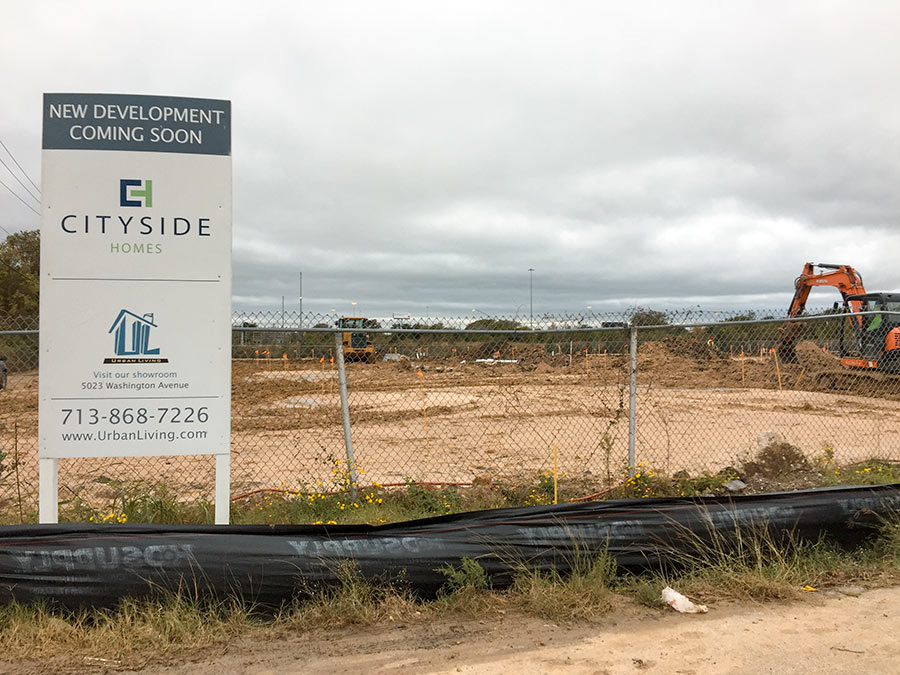
Aside from the presence of workers, the only hint you’ll find that construction has begun on the MDI Superfund site is the sign now standing at the location itself (and the HAIF thread where a user first called attention the whole scene). It’s facing toward the end of Gillespie St., a tiny Fifth Ward road that crosses over Hirsch Rd. and some railroad tracks 3 blocks north of Clinton Dr. before petering out into the eastern edge of the vacant, 35-acre industrial site. There, 3 acres are now giving rise to 42 new townhomes put there Urban Living, the Houston developer that received a multi-million dollar bill in court last week for copying copyrighted townhome plans at a handful of other sites. It’s calling this latest batch East River Yards (an apparent nod to the other industrial tract just south, the gradually crumbling KBR campus that’s been redubbed East River.)
The East River Yards houses will cluster around 3 shared driveways, all of which let out onto Press St.:


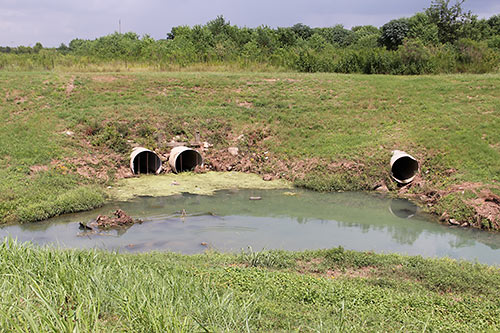 “I moved to Sageglen in 1981 during kindergarten and went to Weber all the way through 6th grade and onto Webster. We played in the ditches catching crawdads, waded through flood waters, and drank the water freely. So many friends lived in Southbend so plenty of time was spent there as well playing throughout the neighborhood on what we thought were playgrounds and neighborhood pools. During the notification process of the contamination, my mother (Chinese and unable to read English at the time) was never aware of any class action suit. I, being a child, only knew we weren’t allowed to drink from the water fountains and didn’t even know what a class action suit or toxic contamination was at the time. Thus, we never signed up for it, nor received any compensation whatsoever. . . After reading all the accounts of vague health issues, I am realizing more and more that my own health issues are pretty much parallel. This cannot be a coincidence. Does anyone know of any sort of data collection on former residents to track the health implications? Or is there a class action suit still available to join; or has anyone filed another considering a lot of these issues are not presenting until adulthood? My biggest concern is: Will these issues be passed down and affect my own child? I just don’t feel this catastrophe and crime against so many people’s health/lives that we are all still/now finding out about should be a ‘closed’ case. We were oblivious kids back then without any idea of how this would affect us in our lives and well-being as adults.” [
“I moved to Sageglen in 1981 during kindergarten and went to Weber all the way through 6th grade and onto Webster. We played in the ditches catching crawdads, waded through flood waters, and drank the water freely. So many friends lived in Southbend so plenty of time was spent there as well playing throughout the neighborhood on what we thought were playgrounds and neighborhood pools. During the notification process of the contamination, my mother (Chinese and unable to read English at the time) was never aware of any class action suit. I, being a child, only knew we weren’t allowed to drink from the water fountains and didn’t even know what a class action suit or toxic contamination was at the time. Thus, we never signed up for it, nor received any compensation whatsoever. . . After reading all the accounts of vague health issues, I am realizing more and more that my own health issues are pretty much parallel. This cannot be a coincidence. Does anyone know of any sort of data collection on former residents to track the health implications? Or is there a class action suit still available to join; or has anyone filed another considering a lot of these issues are not presenting until adulthood? My biggest concern is: Will these issues be passed down and affect my own child? I just don’t feel this catastrophe and crime against so many people’s health/lives that we are all still/now finding out about should be a ‘closed’ case. We were oblivious kids back then without any idea of how this would affect us in our lives and well-being as adults.” [

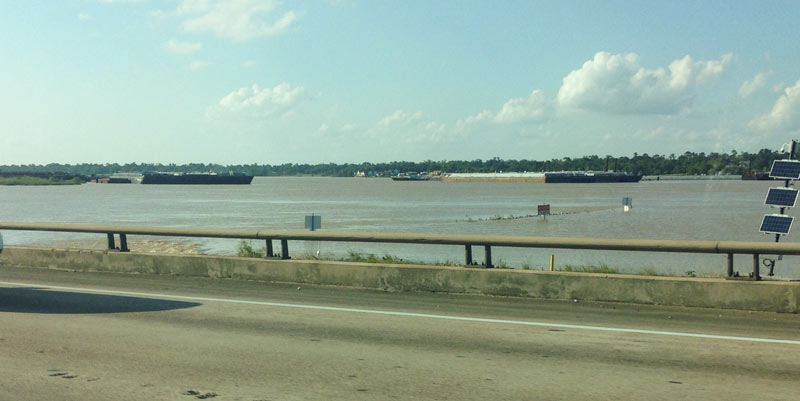
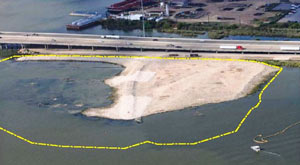
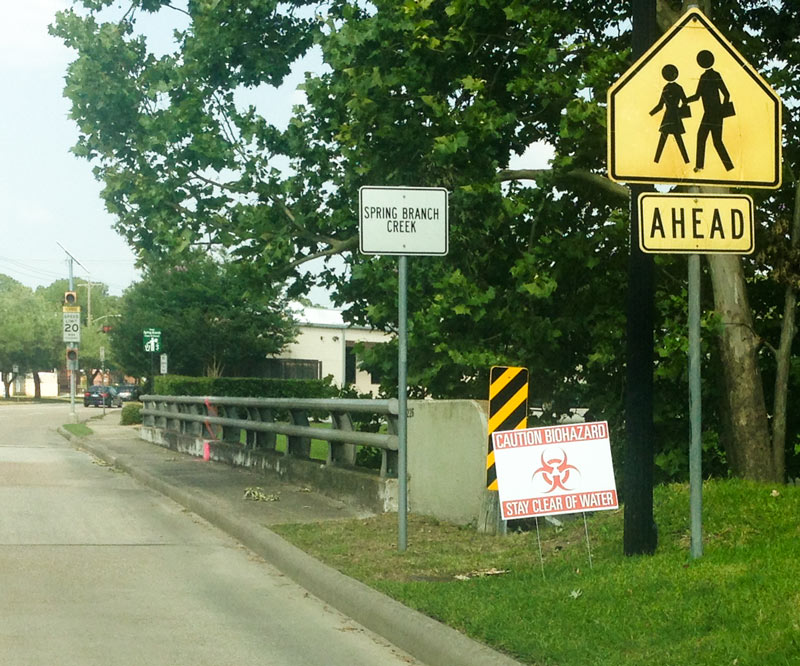

 “I lived there from 1984-1990, from 2nd to 7th grade. I remember there being a ton of empty houses by the end. They never finished the neighborhood either, given that the problems occurred and people knew about it by the end. You’d have entire streets with 4 or 5 houses on it. My friends and I would play baseball, or football in those empty lots. We’d hit baseballs through windows of abandoned homes, and it’d be a dare to ‘go into that ghost house’ to get the ball back.
I remember going back in 1993 or so, and the entire place was empty, boarded up. It was sad. My dad and I hopped the fence and walked back to where our house was. We were there for about 5 minutes when the police came and wanted to know what the hell we were doing. Apparently, it’d become a place for squatters.
By 1995 the
“I lived there from 1984-1990, from 2nd to 7th grade. I remember there being a ton of empty houses by the end. They never finished the neighborhood either, given that the problems occurred and people knew about it by the end. You’d have entire streets with 4 or 5 houses on it. My friends and I would play baseball, or football in those empty lots. We’d hit baseballs through windows of abandoned homes, and it’d be a dare to ‘go into that ghost house’ to get the ball back.
I remember going back in 1993 or so, and the entire place was empty, boarded up. It was sad. My dad and I hopped the fence and walked back to where our house was. We were there for about 5 minutes when the police came and wanted to know what the hell we were doing. Apparently, it’d become a place for squatters.
By 1995 the 
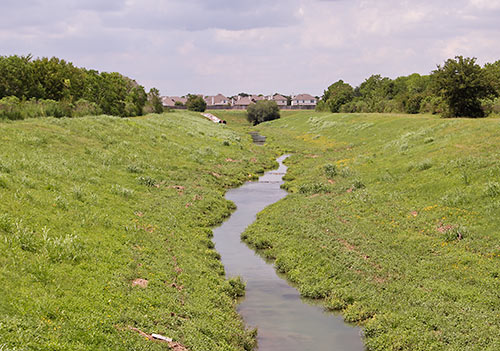
 The endangered historic Falstaff Brewery that once harbored a bunch of scared architecture students in a
The endangered historic Falstaff Brewery that once harbored a bunch of scared architecture students in a 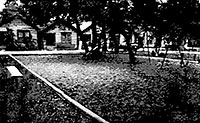 Included in USA Today‘s national list of “ghost factories” —
Included in USA Today‘s national list of “ghost factories” — 